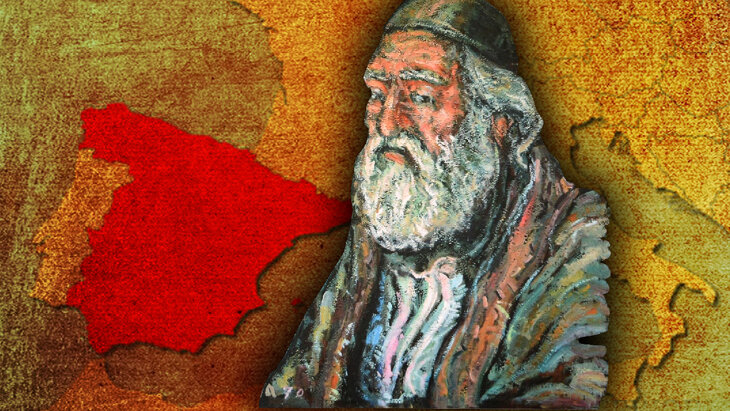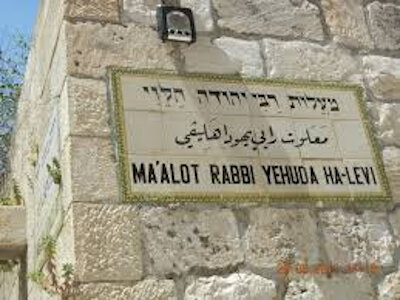 Passover’s Message of Hope in the Aftermath of Oct. 7
Passover’s Message of Hope in the Aftermath of Oct. 7


8 min read
An illustrious poet-philosopher from Spain’s “Golden Age”, Yehuda HaLevi gave us the Kuzari, a systematic and remarkably enduring defense of the Jewish faith. But why did he write it?
He was brilliant rabbi, physician, philosopher, and community leader who lived in Spain during the Jewish Golden Age. Most people who know even a little about Jewish history, will think of Maimonides when they consider the previous sentence. So, it gives us a sense of just how glittering this Golden Age is since I’m describing a different philosopher and doctor, a thinker who is revered to this day for his outstanding poetry.
Yehuda HaLevi has always held a special place in my heart, and not just because I come from the same tribe and affectionately refer to my son as Yehuda HaLevi. The famed philosopher (not my son) was born in Spain around 1075. Two locations are given as his birthplace: Tudela, in northern Spain, or Toledo, close to Madrid. Either way, he certainly spent time living in Toledo, where he worked as a doctor and gained great renown as a thinker and poet.
To appreciate how HaLevi’s magnum opus, The Kuzari, came to be, and to understand its philosophical and cultural role, we need to unpack some of the contradictions and complications of Jewish history in the Iberian Peninsula.
The Jewish Golden Age refers to a period during which Jews flourished, culturally and economically. Jews held important positions in Spanish society and many great Jewish thinkers were able to produce masterpieces with the relative acceptance of broader society.
It was truly a culturally fertile period for the Jewish people. But if history teaches us anything, Jews are only ever contingently welcome.
If history teaches us anything, Jews are only ever contingently welcome.
The Golden Age coincided with the rise of the Umayyad Caliphate in the Iberian Peninsula. The Umayyads ruled over a relatively enlightened and cosmopolitan society (by Middle Ages standards).
Jews were subject to a special tax as non-Muslim residents. But still, they were more or less free to practice, and were able both to participate in broader Spanish society and develop their own communities.
With the dissolution of the Umayyad Kingdom, things went downhill fast. Conditions were not so auspicious under the succeeding Almoravid, and conservative zealot Almohad, rulers. Yehudah HaLevi beat a hasty retreat and landed up in Toledo, which was then in the hands of Christian authorities.
As a cursory look at the turbulent history of Sephardi communities shows, life was no fiesta for Jews under Christian rule either. Things would reach a horrible climax in 1492, when the Christian King and Queen of Spain, Ferdinand and Isabella, signed a decree expelling Jews from the land.
 Statue of Rabbi Yehuda HeLevi, in Caesarea, Israel
Statue of Rabbi Yehuda HeLevi, in Caesarea, Israel
For these two great empires, Christian and Muslim, the struggle for control over Spanish land was no ordinary political dispute; it was an existential battle. The emotive term used by Christian Spain to describe the ultimate victory of Christian forces – the Reconquista, or “reconquest” – is suggestive of how each side believed they were agents of historical destiny. For the Christians, the Reconquista was the battle to take back what was rightfully theirs.
Where did the turbulent passage of Spanish history leave the Jews? At best, tolerated – even welcomed – guests; at worst, despised interlopers. Jews were caught in the crosshairs of the great battle between the major powers of Europe.
This is the context in which HaLevi wrote The Kuzari. The book is a work of ‘apologetics’ which sounds unrelentingly defensive to modern ears. But it is a philosophical genre in which a religion is systematically defended. The work both argues for the validity of the Jewish position and extols a positive vision of the superiority of Judaism.
The underlying question then is why did he feel the need to defend Judaism at all? There was, admittedly, something of a history of Jews being placed on the defensive in medieval Spain. In 1262, Nachmanides1 was forced to debate a catholic representative (who had converted from Judaism). Nachmanides argued brilliantly and impressed the skeptical king. But the notorious event, immortalized as the ‘Disputation of Barcelona,’ was hardly something he opted into willingly.

One reason Yehudah HaLevi wrote the book may be that he chafed against the position of the Jewish communities of Spain, caught up in a clash between Christian and Islamic domination. Jews, HaLevi must have felt, aren’t just players in world history, but bearers of the deepest truths of human progress. After all, amid the geopolitical earthquake of two warring ‘Abrahamic faiths’, it was the Jewish people who delivered the message of Abraham’s kindness and awe of the Creator. Jews are meant to be a light unto the nations, not just a useful community to have around when you need a physician or accountant.2
The Kuzari was originally written in Arabic (no odder than a Jewish scholar living in 21st century New York writing in English) and subsequently translated into Hebrew, with far-reaching influence on Jewish thought.
HaLevi uses the story of the Khazar conversion to frame a sequence of questions between the king and various interlocutors about ultimate religious truth.
The book describes the journey taken by the King of the Khazars as he converts to Judaism. The Khazars were a nomadic tribe who are said to have converted to Judaism. HaLevi uses the story of the Khazar conversion to frame a sequence of questions between the king and various interlocutors about ultimate religious truth.
It starts when a philosopher, a Christian and a Muslim … well they don’t walk into a bar. Rather the Kuzari has them expounding proofs for the Divine Creator’s existence. Proofs which, like any such logical inferences, are ultimately subject to reasoned critique.
Then a Jew parts the saloon doors and enters stage left, to mix several inappropriate metaphors. You want proof of the Creator? I can give you more than mere speculative reason. Here are the signs and wonders, the awe-inspiring miracles, revealed to the Jewish people, and carried down through the generations.3 These are awesome truths you can feel in your bones, not syllogisms for the seminar room.
The succeeding sections of the book deal with a number of subjects, covering themes such as how to understand Divine attributes, a defence of the Oral Law, and critiques of metaphysical traditions, including Aristotelianism. The connecting thread throughout is that the deep truths we are all looking for, whether we’re King of the Khazars or browsing digital devices, are carried down from generation to generation by Jewish communities.
Yehudah HaLevi’s final journey was a personal pilgrimage to the Holy Land. He sailed to Egypt, spending some time in Alexandria and Cairo before heading to Israel.
Why did he go? Considering how little we know about the details of HaLevi’s life, we cannot say for sure. There were likely numerous reasons. But the great defender of the Jewish faith must have wanted to experience the site that housed David and Solomon’s Kingdoms. The land where the High Priest performed the most sacred of rituals each Yom Kippur. Where the Jewish people were not deemed spectators to history, imperilled at all sides yet seen as hostile forces – but the world’s moral guides and a holy nation. Indeed, a whole section of The Kuzari reflects on the superior status of the land of Israel.
As he writes in perhaps his famous poem:
My heart is in the East, and I am at the edge of the West…
It would be easy for me to leave behind all the good things of Spain,
As it is precious for me to behold the dust of the desolate sanctuary.
Unfortunately, it’s unlikely HaLevi ever did behold his 'desolate sanctuary'; he died fairly early in his journey to the Holy Land. We can’t even say for sure that he reached Jerusalem. But the stairs that lead down to the Western Wall, one of my favorite streets in the world, are named after Yehuda HaLevi himself. Perhaps because of the path he paved leads this way even if he was unable to reach the destination himself.

His spiritual influence remains immortal, as the paradigmatic thinker of Judaism as a religion of history, tradition, imagination and lived experience. HaLevi, then, wasn’t so much a philosopher and a poet as a poet-philosopher. He wasn’t just a great intellectual but one who taught us the value of embodying our tradition.
